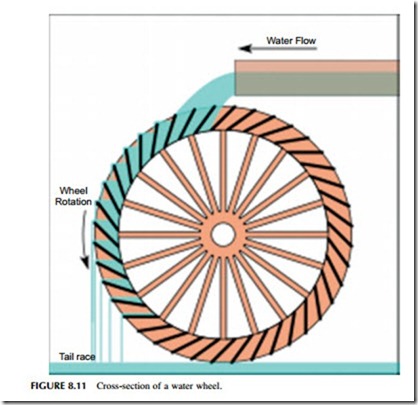SMALL HYDROPOWER
Small hydropower plants are defined as much by regulatory regimes as by their inherent design features. Plants below a certain size usually qualify as new renewable generation and these are called small hydropower plants. The limit varies from country to country. In Sweden, for example, the upper size of a small hydropower plant that can attract support is 1.5 MW. In Italy the limit is 3 MW, in France 12 MW, in the United Kingdom 20 MW, and in Canada and the United States it is between 30 MW and 50 MW.
The global installed capacity of small hydropower plants is not known precisely but is probably around 50,000 MW, although it could be significantly higher. The potential for future development is equally uncertain but the Inter- national Energy Agency has suggested that there may be 150,000–200,000 MW capable of development.
The design of a small hydropower plant depends very much on its size. Those in the small hydropower category of Table 8.3 (1 MW to between 10 MW and 30 MW) will be approached in a similar way to a large hydropower project. At this size, dam construction is less likely to be cost effective but some sort of barrage may be employed. At the smaller end of the range off-the-shelf rather than site-specific turbines are also likely to be used. In most cases these will be the types discussed earlier for large hydropower schemes.
Mini- and micro-hydropower plants of less than 1 MW in size are likely to be approached differently. Here cost becomes the overriding concern and a range of novel techniques including the use of cheap pumps as turbines and inflatable barrages may be employed to keep costs down.
One major difference between large and small hydropower is the breakdown of head height into categories. For a small hydropower plant a head above 100 m will be considered a high head and any project with a head of this or higher will employ a high-head turbine such as a Pelton turbine. For very small projects a Pelton turbine may be used at even lower head heights. Projects with heads between 30 m and 100 m are classified as medium-head schemes, while anything under 30 m qualifies as a low-head plant.
Plant design will be much simpler in a small hydropower scheme. Most will be run-of-river (or run-of-stream) and any intake structures, where used, are likely to be rudimentary to keep costs low. For larger plants a weir may be employed. Others will take water directly without any type of barrage. In many cases the turbine generator will be placed directly into the waterway.
If water is extracted from the river or stream it may be carried some distance through the equivalent of a headrace, but more commonly it will be fed directly into a penstock-type conduit that carries it directly into the turbine. Penstock length can affect project costs significantly so this will be kept as short as possible.
Turbine types for small hydropower schemes will depend on head height; Pelton turbines for high-head, Turgo and Francis for medium-head, and propeller and Kaplan turbines for low-head applications. Other turbines are also com- monly used. These include the cross-flow turbine–a low-cost type of impulse turbine–the Archimedes Screw and the Gorlov turbine that is a little like a vertical-axis wind turbine that operates under water. Simple paddle-type water wheels are also common (Figure 8.11). For very small applications cheap pumps can be used in reverse to make turbine generators. These are known
as pumps-for-turbines (PATs) and can be used with head heights of 13–75 m to build very cheap hydropower facilities. Small propeller turbines fitted with sealed generators can also be dropped directly into a stream to provide a hydropower-generating system.
While larger small hydropower schemes may use synchronous generators of the sort used in large plants, many small plants employ asynchronous generators that rely on the grid to help them control their speed of operation. In some cases these are simply motors being used in reverse to generate power. The efficiency of such small asynchronous generators is much lower than for large generators.
Small hydropower schemes tend to be relatively more expensive than larger schemes because costs of many of the components do not fall in line with size. The cost of a grid connection can become a large component of the small hydro- power scheme and a feasibility study may take a large share of the budget. The extra cost can still be economical if the small hydropower scheme is supplying power directly to consumers where it will be competing with the retail cost of electricity rather than the wholesale cost. Small hydropower schemes can also be extremely effective in supplying power to remote communities far from a grid, especially when the alternative is diesel power.
